Logistic Management Tools for Honeycut Warehouse Sustainability
VerifiedAdded on 2021/04/16
|11
|2680
|23
Report
AI Summary
This report examines the sustainability practices of Honeycut Warehouse and Shipping Corporation, focusing on the application of logistic management tools to address challenges such as shipment costs, freight transportation, and environmental impact. The report explores the implementation of Optimal Production Technology (OPT), accounting tools, transportation management, good organization, workforce management software, and a Warehouse Management System (WMS). It emphasizes the importance of these tools in streamlining operations, reducing costs, improving customer satisfaction, and minimizing environmental pollution. The report highlights the significance of lean inventory, efficient space utilization, organized workstations, and strategic partnerships. Furthermore, the report suggests measures to reduce emissions, such as using electric forklifts and installing air quality monitoring systems. The conclusion underscores the importance of logistic tools for productivity, customer satisfaction, and environmental responsibility. The report also references the importance of accounting tools and transportation management for the success of Honeycut warehouse.
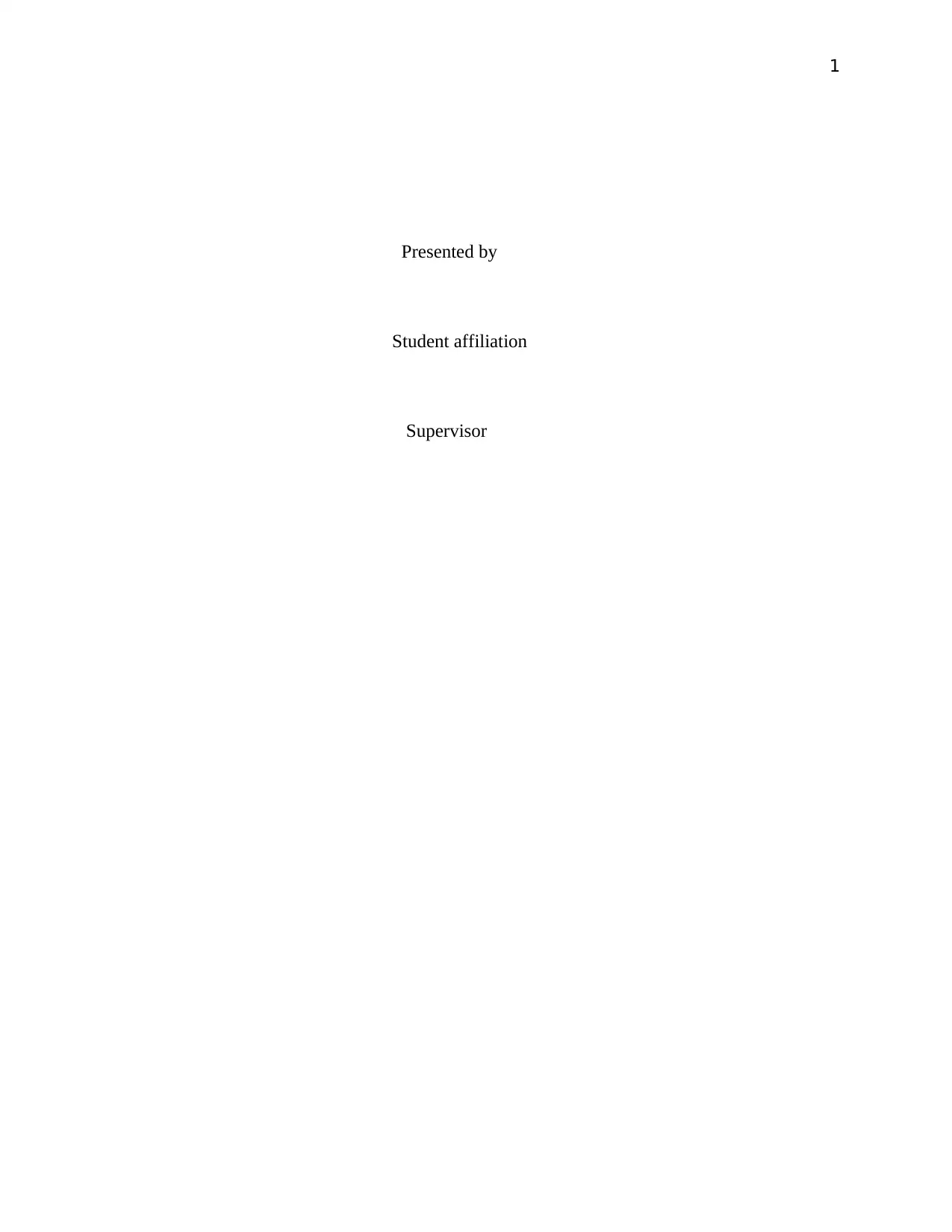
1
Presented by
Student affiliation
Supervisor
Presented by
Student affiliation
Supervisor
Paraphrase This Document
Need a fresh take? Get an instant paraphrase of this document with our AI Paraphraser
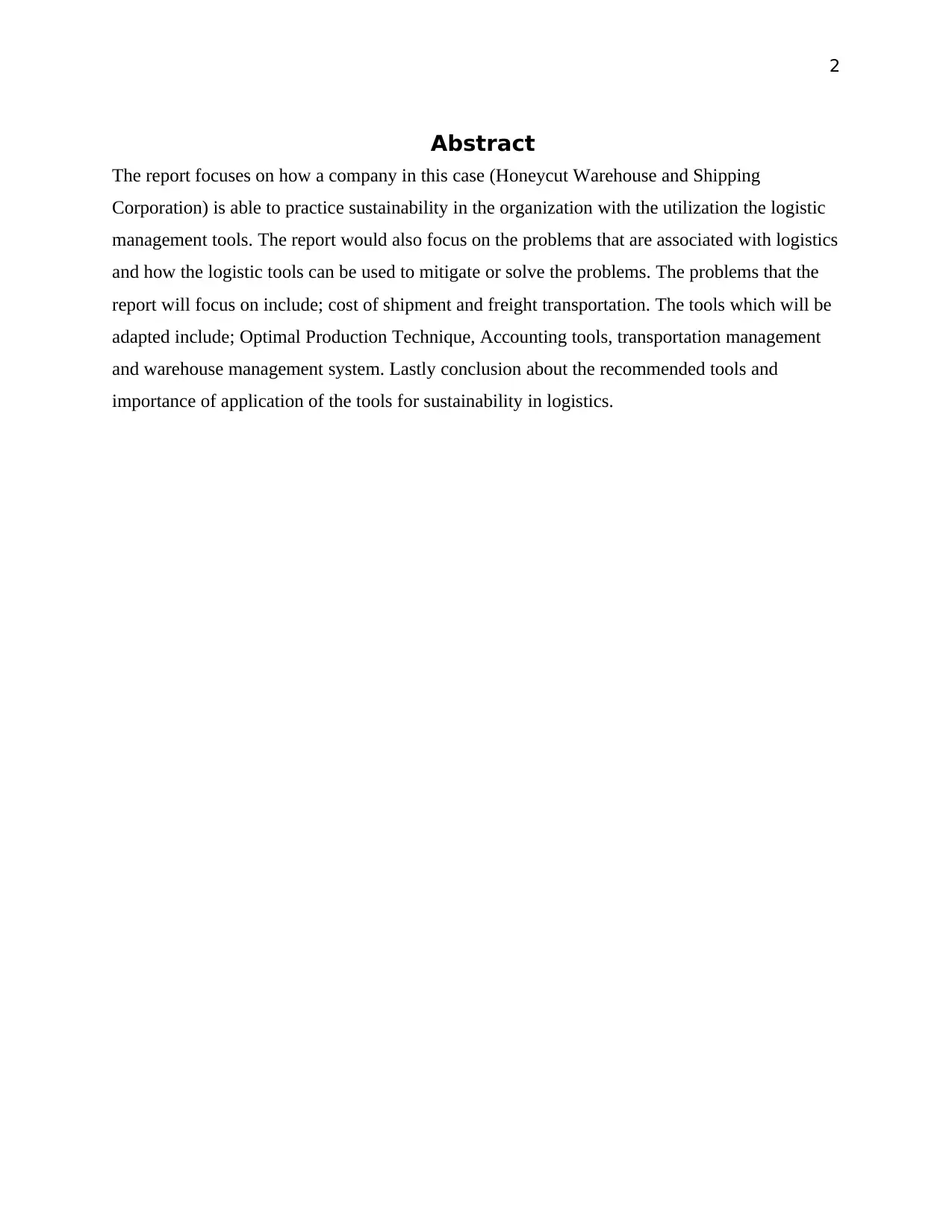
2
Abstract
The report focuses on how a company in this case (Honeycut Warehouse and Shipping
Corporation) is able to practice sustainability in the organization with the utilization the logistic
management tools. The report would also focus on the problems that are associated with logistics
and how the logistic tools can be used to mitigate or solve the problems. The problems that the
report will focus on include; cost of shipment and freight transportation. The tools which will be
adapted include; Optimal Production Technique, Accounting tools, transportation management
and warehouse management system. Lastly conclusion about the recommended tools and
importance of application of the tools for sustainability in logistics.
Abstract
The report focuses on how a company in this case (Honeycut Warehouse and Shipping
Corporation) is able to practice sustainability in the organization with the utilization the logistic
management tools. The report would also focus on the problems that are associated with logistics
and how the logistic tools can be used to mitigate or solve the problems. The problems that the
report will focus on include; cost of shipment and freight transportation. The tools which will be
adapted include; Optimal Production Technique, Accounting tools, transportation management
and warehouse management system. Lastly conclusion about the recommended tools and
importance of application of the tools for sustainability in logistics.
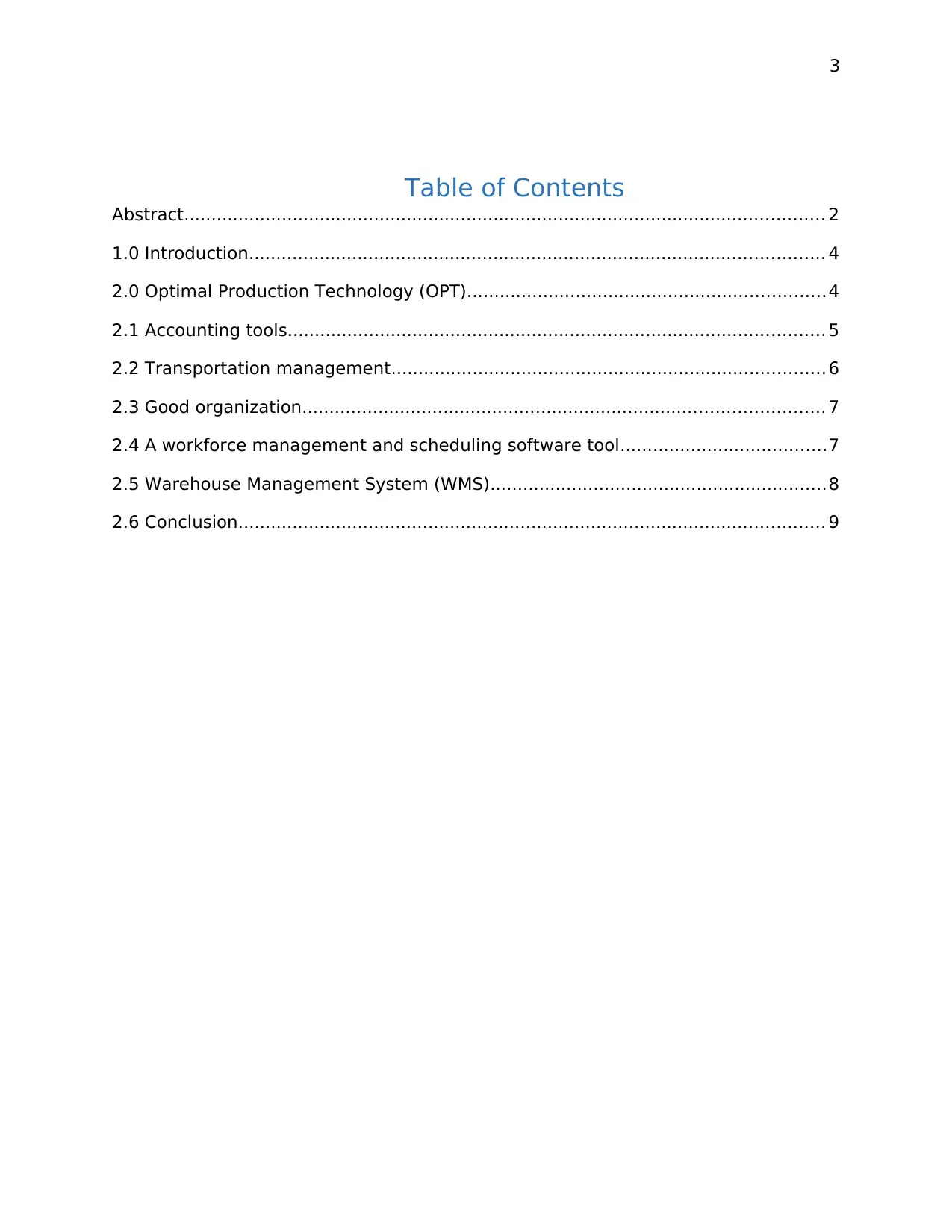
3
Table of Contents
Abstract...................................................................................................................... 2
1.0 Introduction.......................................................................................................... 4
2.0 Optimal Production Technology (OPT)..................................................................4
2.1 Accounting tools................................................................................................... 5
2.2 Transportation management................................................................................ 6
2.3 Good organization................................................................................................ 7
2.4 A workforce management and scheduling software tool......................................7
2.5 Warehouse Management System (WMS)..............................................................8
2.6 Conclusion............................................................................................................ 9
Table of Contents
Abstract...................................................................................................................... 2
1.0 Introduction.......................................................................................................... 4
2.0 Optimal Production Technology (OPT)..................................................................4
2.1 Accounting tools................................................................................................... 5
2.2 Transportation management................................................................................ 6
2.3 Good organization................................................................................................ 7
2.4 A workforce management and scheduling software tool......................................7
2.5 Warehouse Management System (WMS)..............................................................8
2.6 Conclusion............................................................................................................ 9
⊘ This is a preview!⊘
Do you want full access?
Subscribe today to unlock all pages.

Trusted by 1+ million students worldwide
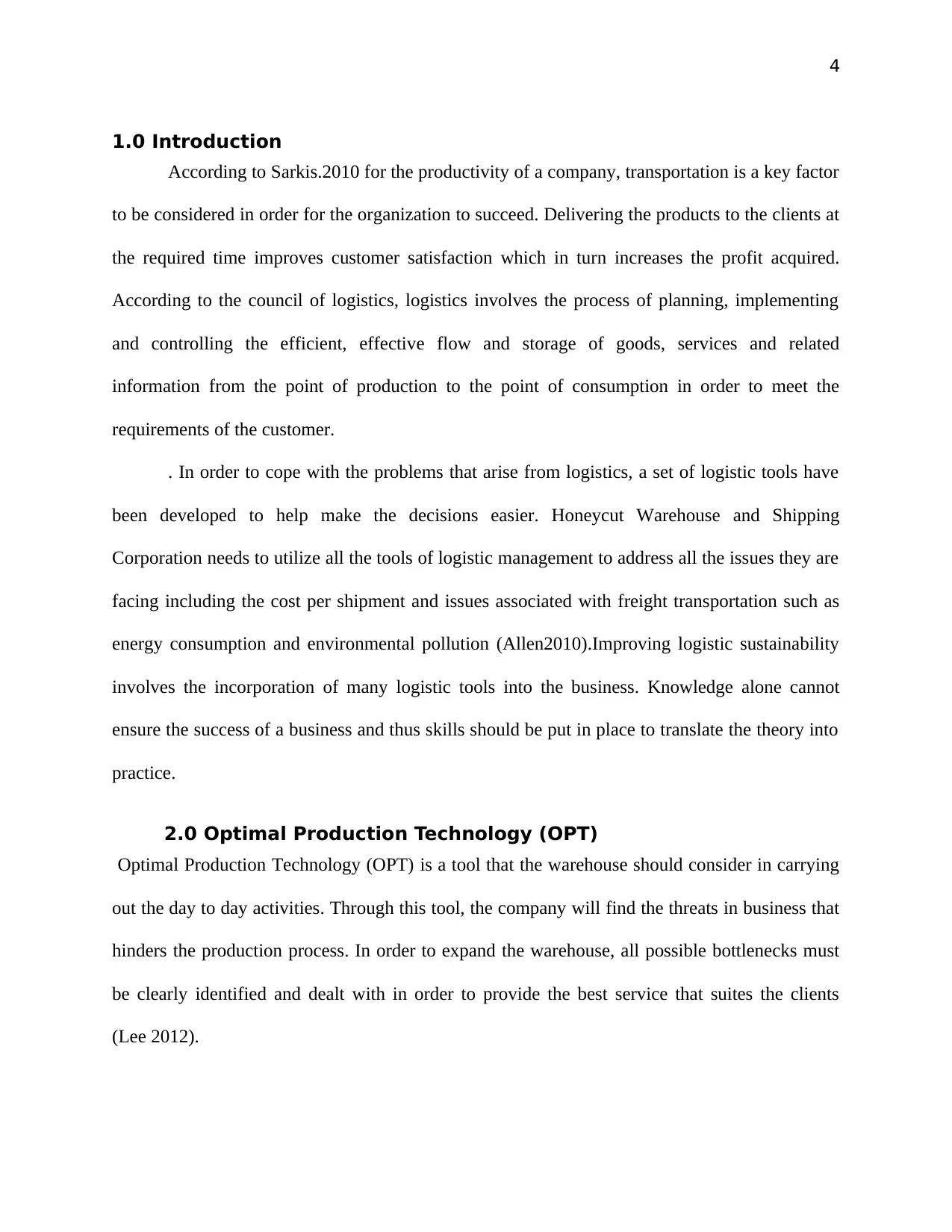
4
1.0 Introduction
According to Sarkis.2010 for the productivity of a company, transportation is a key factor
to be considered in order for the organization to succeed. Delivering the products to the clients at
the required time improves customer satisfaction which in turn increases the profit acquired.
According to the council of logistics, logistics involves the process of planning, implementing
and controlling the efficient, effective flow and storage of goods, services and related
information from the point of production to the point of consumption in order to meet the
requirements of the customer.
. In order to cope with the problems that arise from logistics, a set of logistic tools have
been developed to help make the decisions easier. Honeycut Warehouse and Shipping
Corporation needs to utilize all the tools of logistic management to address all the issues they are
facing including the cost per shipment and issues associated with freight transportation such as
energy consumption and environmental pollution (Allen2010).Improving logistic sustainability
involves the incorporation of many logistic tools into the business. Knowledge alone cannot
ensure the success of a business and thus skills should be put in place to translate the theory into
practice.
2.0 Optimal Production Technology (OPT)
Optimal Production Technology (OPT) is a tool that the warehouse should consider in carrying
out the day to day activities. Through this tool, the company will find the threats in business that
hinders the production process. In order to expand the warehouse, all possible bottlenecks must
be clearly identified and dealt with in order to provide the best service that suites the clients
(Lee 2012).
1.0 Introduction
According to Sarkis.2010 for the productivity of a company, transportation is a key factor
to be considered in order for the organization to succeed. Delivering the products to the clients at
the required time improves customer satisfaction which in turn increases the profit acquired.
According to the council of logistics, logistics involves the process of planning, implementing
and controlling the efficient, effective flow and storage of goods, services and related
information from the point of production to the point of consumption in order to meet the
requirements of the customer.
. In order to cope with the problems that arise from logistics, a set of logistic tools have
been developed to help make the decisions easier. Honeycut Warehouse and Shipping
Corporation needs to utilize all the tools of logistic management to address all the issues they are
facing including the cost per shipment and issues associated with freight transportation such as
energy consumption and environmental pollution (Allen2010).Improving logistic sustainability
involves the incorporation of many logistic tools into the business. Knowledge alone cannot
ensure the success of a business and thus skills should be put in place to translate the theory into
practice.
2.0 Optimal Production Technology (OPT)
Optimal Production Technology (OPT) is a tool that the warehouse should consider in carrying
out the day to day activities. Through this tool, the company will find the threats in business that
hinders the production process. In order to expand the warehouse, all possible bottlenecks must
be clearly identified and dealt with in order to provide the best service that suites the clients
(Lee 2012).
Paraphrase This Document
Need a fresh take? Get an instant paraphrase of this document with our AI Paraphraser
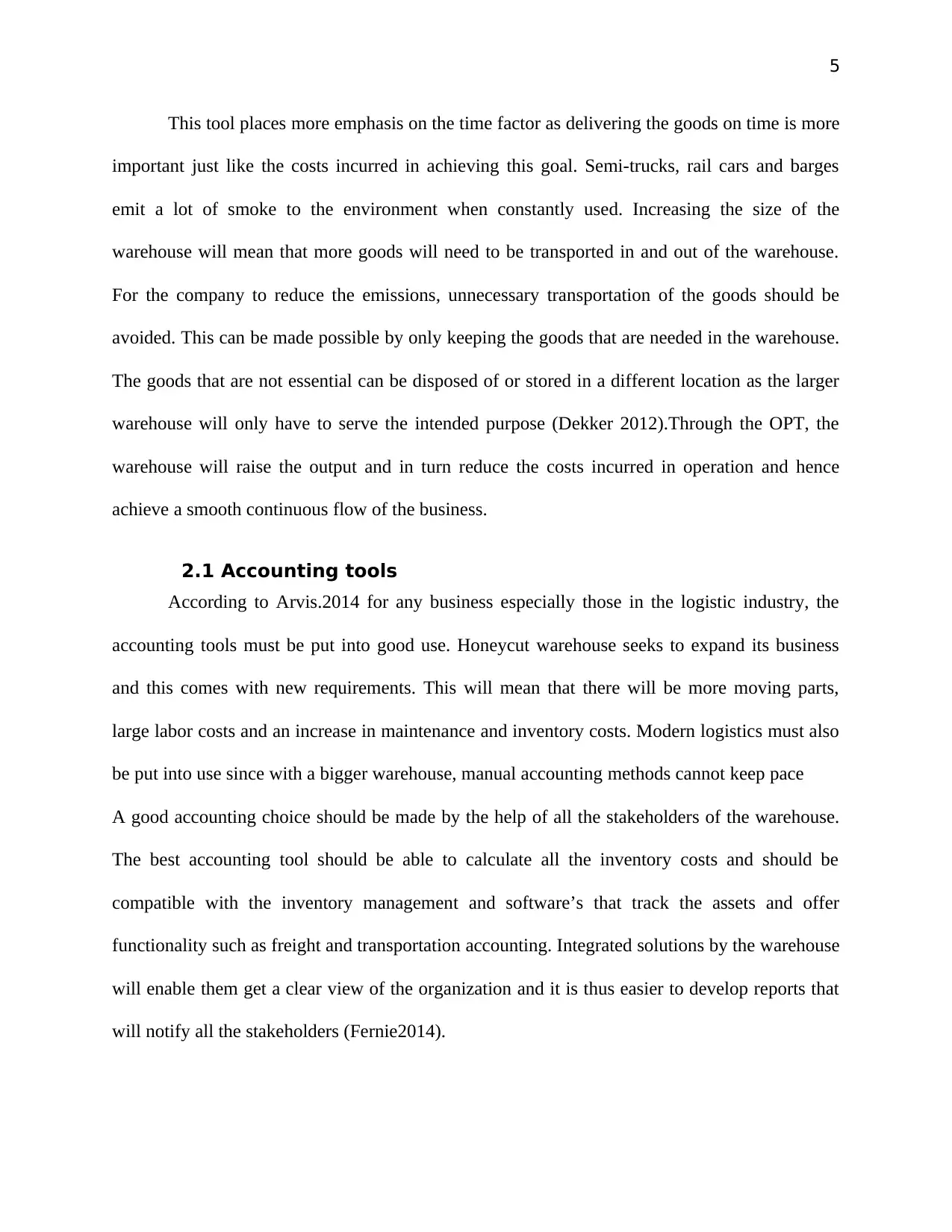
5
This tool places more emphasis on the time factor as delivering the goods on time is more
important just like the costs incurred in achieving this goal. Semi-trucks, rail cars and barges
emit a lot of smoke to the environment when constantly used. Increasing the size of the
warehouse will mean that more goods will need to be transported in and out of the warehouse.
For the company to reduce the emissions, unnecessary transportation of the goods should be
avoided. This can be made possible by only keeping the goods that are needed in the warehouse.
The goods that are not essential can be disposed of or stored in a different location as the larger
warehouse will only have to serve the intended purpose (Dekker 2012).Through the OPT, the
warehouse will raise the output and in turn reduce the costs incurred in operation and hence
achieve a smooth continuous flow of the business.
2.1 Accounting tools
According to Arvis.2014 for any business especially those in the logistic industry, the
accounting tools must be put into good use. Honeycut warehouse seeks to expand its business
and this comes with new requirements. This will mean that there will be more moving parts,
large labor costs and an increase in maintenance and inventory costs. Modern logistics must also
be put into use since with a bigger warehouse, manual accounting methods cannot keep pace
A good accounting choice should be made by the help of all the stakeholders of the warehouse.
The best accounting tool should be able to calculate all the inventory costs and should be
compatible with the inventory management and software’s that track the assets and offer
functionality such as freight and transportation accounting. Integrated solutions by the warehouse
will enable them get a clear view of the organization and it is thus easier to develop reports that
will notify all the stakeholders (Fernie2014).
This tool places more emphasis on the time factor as delivering the goods on time is more
important just like the costs incurred in achieving this goal. Semi-trucks, rail cars and barges
emit a lot of smoke to the environment when constantly used. Increasing the size of the
warehouse will mean that more goods will need to be transported in and out of the warehouse.
For the company to reduce the emissions, unnecessary transportation of the goods should be
avoided. This can be made possible by only keeping the goods that are needed in the warehouse.
The goods that are not essential can be disposed of or stored in a different location as the larger
warehouse will only have to serve the intended purpose (Dekker 2012).Through the OPT, the
warehouse will raise the output and in turn reduce the costs incurred in operation and hence
achieve a smooth continuous flow of the business.
2.1 Accounting tools
According to Arvis.2014 for any business especially those in the logistic industry, the
accounting tools must be put into good use. Honeycut warehouse seeks to expand its business
and this comes with new requirements. This will mean that there will be more moving parts,
large labor costs and an increase in maintenance and inventory costs. Modern logistics must also
be put into use since with a bigger warehouse, manual accounting methods cannot keep pace
A good accounting choice should be made by the help of all the stakeholders of the warehouse.
The best accounting tool should be able to calculate all the inventory costs and should be
compatible with the inventory management and software’s that track the assets and offer
functionality such as freight and transportation accounting. Integrated solutions by the warehouse
will enable them get a clear view of the organization and it is thus easier to develop reports that
will notify all the stakeholders (Fernie2014).
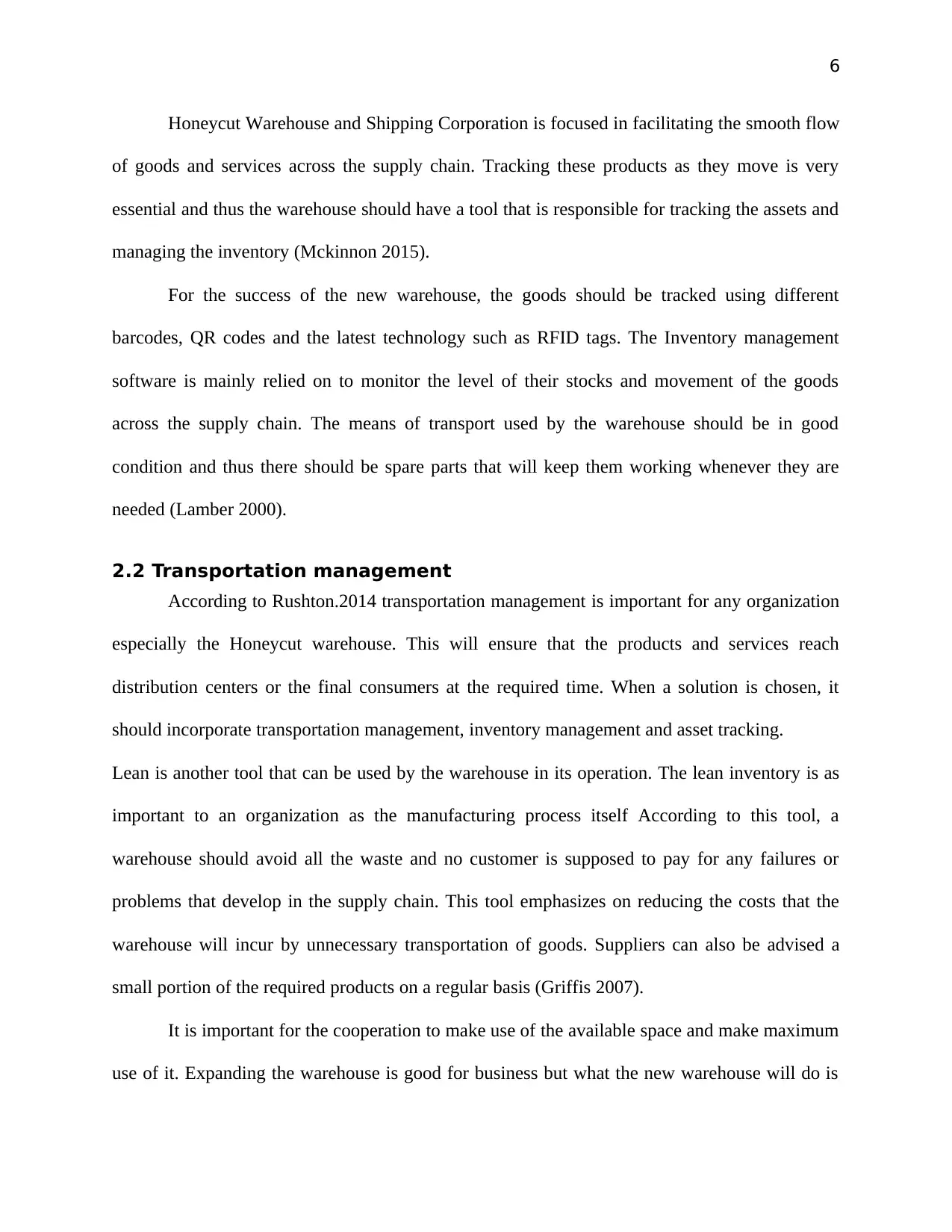
6
Honeycut Warehouse and Shipping Corporation is focused in facilitating the smooth flow
of goods and services across the supply chain. Tracking these products as they move is very
essential and thus the warehouse should have a tool that is responsible for tracking the assets and
managing the inventory (Mckinnon 2015).
For the success of the new warehouse, the goods should be tracked using different
barcodes, QR codes and the latest technology such as RFID tags. The Inventory management
software is mainly relied on to monitor the level of their stocks and movement of the goods
across the supply chain. The means of transport used by the warehouse should be in good
condition and thus there should be spare parts that will keep them working whenever they are
needed (Lamber 2000).
2.2 Transportation management
According to Rushton.2014 transportation management is important for any organization
especially the Honeycut warehouse. This will ensure that the products and services reach
distribution centers or the final consumers at the required time. When a solution is chosen, it
should incorporate transportation management, inventory management and asset tracking.
Lean is another tool that can be used by the warehouse in its operation. The lean inventory is as
important to an organization as the manufacturing process itself According to this tool, a
warehouse should avoid all the waste and no customer is supposed to pay for any failures or
problems that develop in the supply chain. This tool emphasizes on reducing the costs that the
warehouse will incur by unnecessary transportation of goods. Suppliers can also be advised a
small portion of the required products on a regular basis (Griffis 2007).
It is important for the cooperation to make use of the available space and make maximum
use of it. Expanding the warehouse is good for business but what the new warehouse will do is
Honeycut Warehouse and Shipping Corporation is focused in facilitating the smooth flow
of goods and services across the supply chain. Tracking these products as they move is very
essential and thus the warehouse should have a tool that is responsible for tracking the assets and
managing the inventory (Mckinnon 2015).
For the success of the new warehouse, the goods should be tracked using different
barcodes, QR codes and the latest technology such as RFID tags. The Inventory management
software is mainly relied on to monitor the level of their stocks and movement of the goods
across the supply chain. The means of transport used by the warehouse should be in good
condition and thus there should be spare parts that will keep them working whenever they are
needed (Lamber 2000).
2.2 Transportation management
According to Rushton.2014 transportation management is important for any organization
especially the Honeycut warehouse. This will ensure that the products and services reach
distribution centers or the final consumers at the required time. When a solution is chosen, it
should incorporate transportation management, inventory management and asset tracking.
Lean is another tool that can be used by the warehouse in its operation. The lean inventory is as
important to an organization as the manufacturing process itself According to this tool, a
warehouse should avoid all the waste and no customer is supposed to pay for any failures or
problems that develop in the supply chain. This tool emphasizes on reducing the costs that the
warehouse will incur by unnecessary transportation of goods. Suppliers can also be advised a
small portion of the required products on a regular basis (Griffis 2007).
It is important for the cooperation to make use of the available space and make maximum
use of it. Expanding the warehouse is good for business but what the new warehouse will do is
⊘ This is a preview!⊘
Do you want full access?
Subscribe today to unlock all pages.

Trusted by 1+ million students worldwide
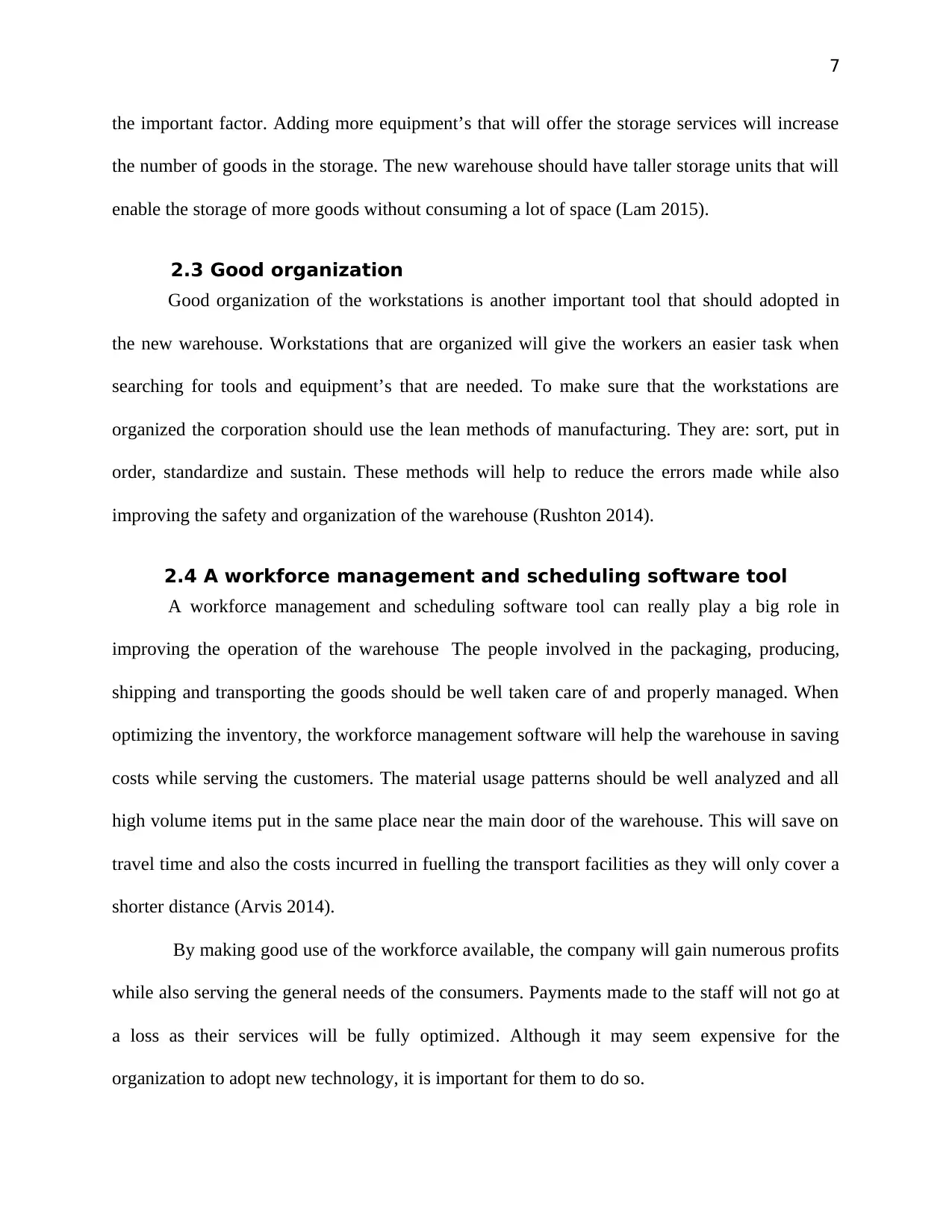
7
the important factor. Adding more equipment’s that will offer the storage services will increase
the number of goods in the storage. The new warehouse should have taller storage units that will
enable the storage of more goods without consuming a lot of space (Lam 2015).
2.3 Good organization
Good organization of the workstations is another important tool that should adopted in
the new warehouse. Workstations that are organized will give the workers an easier task when
searching for tools and equipment’s that are needed. To make sure that the workstations are
organized the corporation should use the lean methods of manufacturing. They are: sort, put in
order, standardize and sustain. These methods will help to reduce the errors made while also
improving the safety and organization of the warehouse (Rushton 2014).
2.4 A workforce management and scheduling software tool
A workforce management and scheduling software tool can really play a big role in
improving the operation of the warehouse The people involved in the packaging, producing,
shipping and transporting the goods should be well taken care of and properly managed. When
optimizing the inventory, the workforce management software will help the warehouse in saving
costs while serving the customers. The material usage patterns should be well analyzed and all
high volume items put in the same place near the main door of the warehouse. This will save on
travel time and also the costs incurred in fuelling the transport facilities as they will only cover a
shorter distance (Arvis 2014).
By making good use of the workforce available, the company will gain numerous profits
while also serving the general needs of the consumers. Payments made to the staff will not go at
a loss as their services will be fully optimized. Although it may seem expensive for the
organization to adopt new technology, it is important for them to do so.
the important factor. Adding more equipment’s that will offer the storage services will increase
the number of goods in the storage. The new warehouse should have taller storage units that will
enable the storage of more goods without consuming a lot of space (Lam 2015).
2.3 Good organization
Good organization of the workstations is another important tool that should adopted in
the new warehouse. Workstations that are organized will give the workers an easier task when
searching for tools and equipment’s that are needed. To make sure that the workstations are
organized the corporation should use the lean methods of manufacturing. They are: sort, put in
order, standardize and sustain. These methods will help to reduce the errors made while also
improving the safety and organization of the warehouse (Rushton 2014).
2.4 A workforce management and scheduling software tool
A workforce management and scheduling software tool can really play a big role in
improving the operation of the warehouse The people involved in the packaging, producing,
shipping and transporting the goods should be well taken care of and properly managed. When
optimizing the inventory, the workforce management software will help the warehouse in saving
costs while serving the customers. The material usage patterns should be well analyzed and all
high volume items put in the same place near the main door of the warehouse. This will save on
travel time and also the costs incurred in fuelling the transport facilities as they will only cover a
shorter distance (Arvis 2014).
By making good use of the workforce available, the company will gain numerous profits
while also serving the general needs of the consumers. Payments made to the staff will not go at
a loss as their services will be fully optimized. Although it may seem expensive for the
organization to adopt new technology, it is important for them to do so.
Paraphrase This Document
Need a fresh take? Get an instant paraphrase of this document with our AI Paraphraser
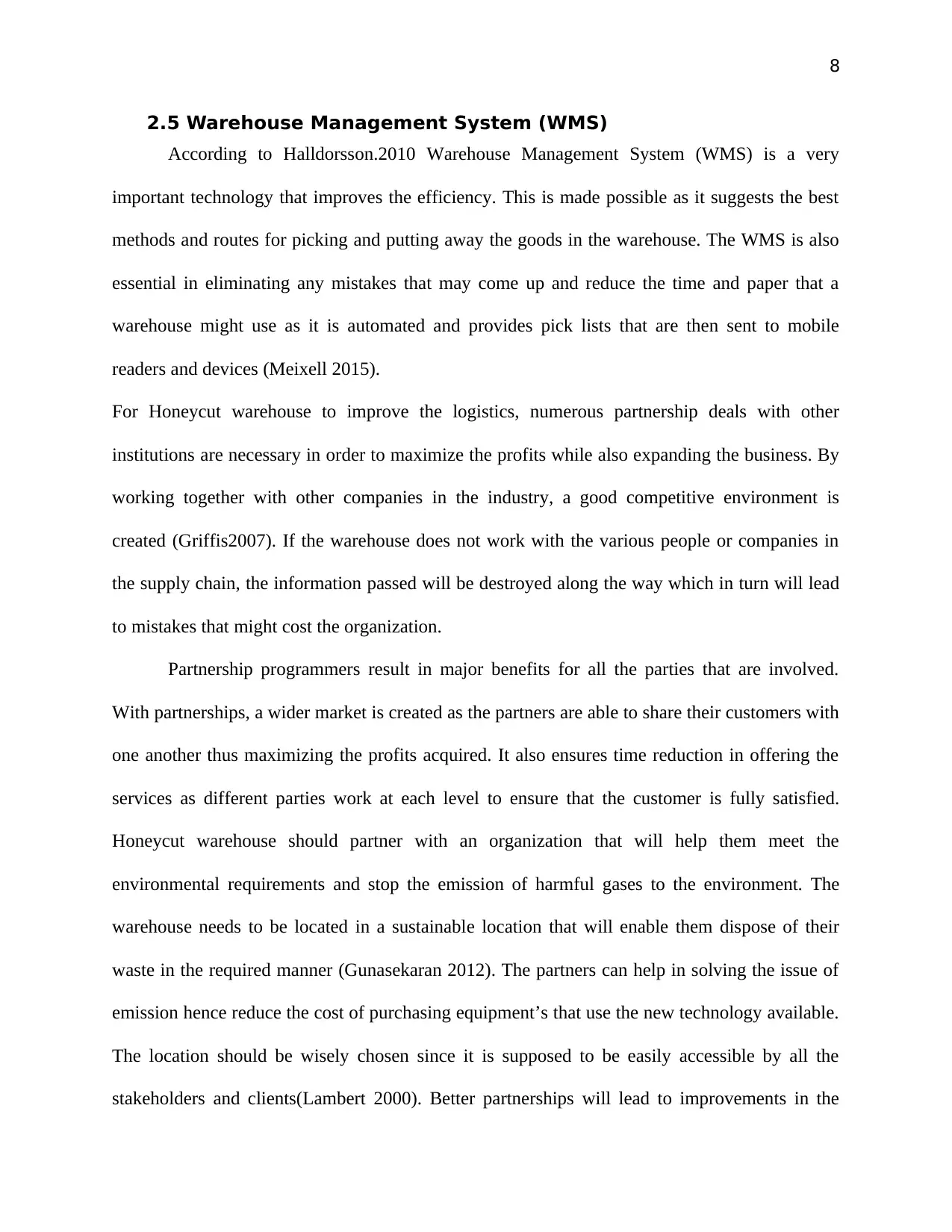
8
2.5 Warehouse Management System (WMS)
According to Halldorsson.2010 Warehouse Management System (WMS) is a very
important technology that improves the efficiency. This is made possible as it suggests the best
methods and routes for picking and putting away the goods in the warehouse. The WMS is also
essential in eliminating any mistakes that may come up and reduce the time and paper that a
warehouse might use as it is automated and provides pick lists that are then sent to mobile
readers and devices (Meixell 2015).
For Honeycut warehouse to improve the logistics, numerous partnership deals with other
institutions are necessary in order to maximize the profits while also expanding the business. By
working together with other companies in the industry, a good competitive environment is
created (Griffis2007). If the warehouse does not work with the various people or companies in
the supply chain, the information passed will be destroyed along the way which in turn will lead
to mistakes that might cost the organization.
Partnership programmers result in major benefits for all the parties that are involved.
With partnerships, a wider market is created as the partners are able to share their customers with
one another thus maximizing the profits acquired. It also ensures time reduction in offering the
services as different parties work at each level to ensure that the customer is fully satisfied.
Honeycut warehouse should partner with an organization that will help them meet the
environmental requirements and stop the emission of harmful gases to the environment. The
warehouse needs to be located in a sustainable location that will enable them dispose of their
waste in the required manner (Gunasekaran 2012). The partners can help in solving the issue of
emission hence reduce the cost of purchasing equipment’s that use the new technology available.
The location should be wisely chosen since it is supposed to be easily accessible by all the
stakeholders and clients(Lambert 2000). Better partnerships will lead to improvements in the
2.5 Warehouse Management System (WMS)
According to Halldorsson.2010 Warehouse Management System (WMS) is a very
important technology that improves the efficiency. This is made possible as it suggests the best
methods and routes for picking and putting away the goods in the warehouse. The WMS is also
essential in eliminating any mistakes that may come up and reduce the time and paper that a
warehouse might use as it is automated and provides pick lists that are then sent to mobile
readers and devices (Meixell 2015).
For Honeycut warehouse to improve the logistics, numerous partnership deals with other
institutions are necessary in order to maximize the profits while also expanding the business. By
working together with other companies in the industry, a good competitive environment is
created (Griffis2007). If the warehouse does not work with the various people or companies in
the supply chain, the information passed will be destroyed along the way which in turn will lead
to mistakes that might cost the organization.
Partnership programmers result in major benefits for all the parties that are involved.
With partnerships, a wider market is created as the partners are able to share their customers with
one another thus maximizing the profits acquired. It also ensures time reduction in offering the
services as different parties work at each level to ensure that the customer is fully satisfied.
Honeycut warehouse should partner with an organization that will help them meet the
environmental requirements and stop the emission of harmful gases to the environment. The
warehouse needs to be located in a sustainable location that will enable them dispose of their
waste in the required manner (Gunasekaran 2012). The partners can help in solving the issue of
emission hence reduce the cost of purchasing equipment’s that use the new technology available.
The location should be wisely chosen since it is supposed to be easily accessible by all the
stakeholders and clients(Lambert 2000). Better partnerships will lead to improvements in the
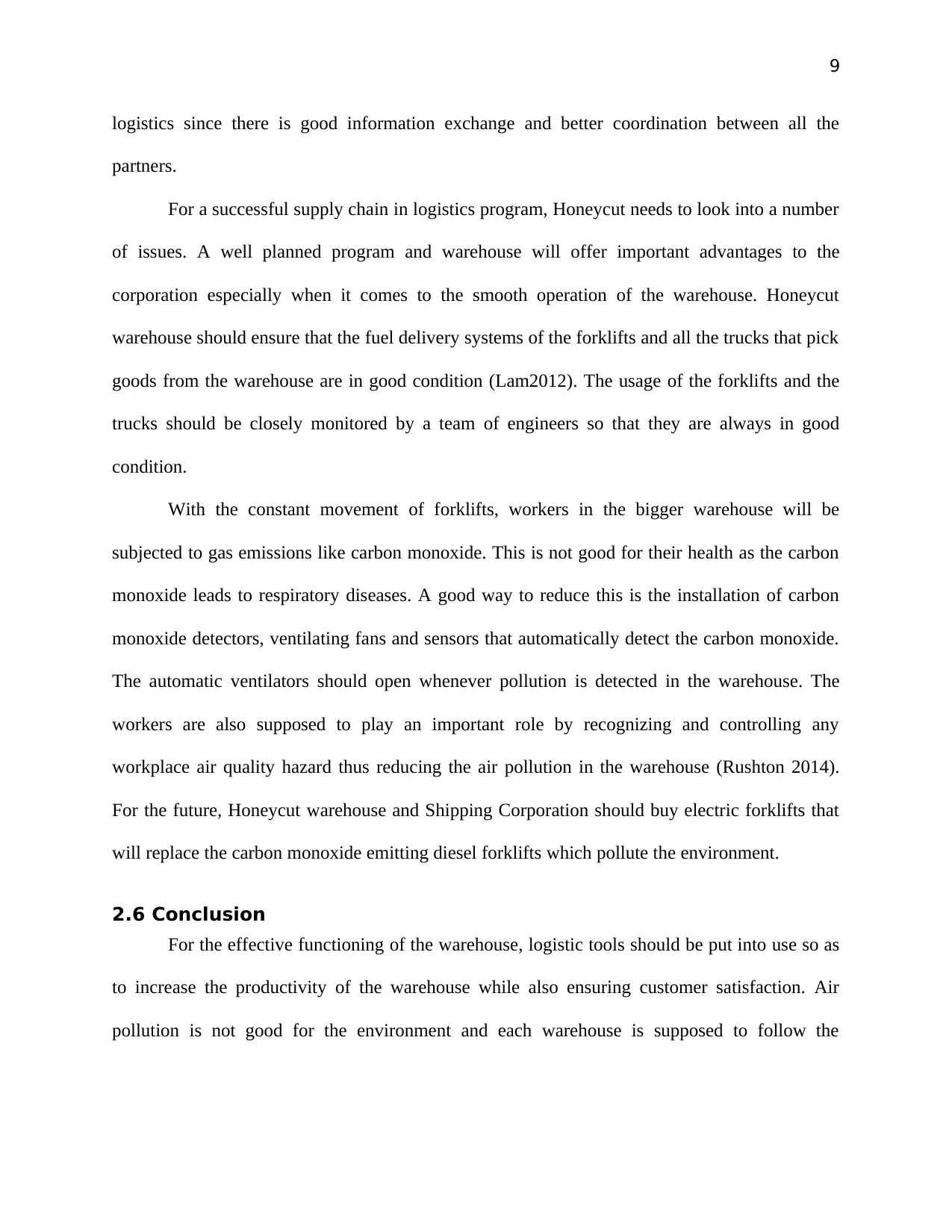
9
logistics since there is good information exchange and better coordination between all the
partners.
For a successful supply chain in logistics program, Honeycut needs to look into a number
of issues. A well planned program and warehouse will offer important advantages to the
corporation especially when it comes to the smooth operation of the warehouse. Honeycut
warehouse should ensure that the fuel delivery systems of the forklifts and all the trucks that pick
goods from the warehouse are in good condition (Lam2012). The usage of the forklifts and the
trucks should be closely monitored by a team of engineers so that they are always in good
condition.
With the constant movement of forklifts, workers in the bigger warehouse will be
subjected to gas emissions like carbon monoxide. This is not good for their health as the carbon
monoxide leads to respiratory diseases. A good way to reduce this is the installation of carbon
monoxide detectors, ventilating fans and sensors that automatically detect the carbon monoxide.
The automatic ventilators should open whenever pollution is detected in the warehouse. The
workers are also supposed to play an important role by recognizing and controlling any
workplace air quality hazard thus reducing the air pollution in the warehouse (Rushton 2014).
For the future, Honeycut warehouse and Shipping Corporation should buy electric forklifts that
will replace the carbon monoxide emitting diesel forklifts which pollute the environment.
2.6 Conclusion
For the effective functioning of the warehouse, logistic tools should be put into use so as
to increase the productivity of the warehouse while also ensuring customer satisfaction. Air
pollution is not good for the environment and each warehouse is supposed to follow the
logistics since there is good information exchange and better coordination between all the
partners.
For a successful supply chain in logistics program, Honeycut needs to look into a number
of issues. A well planned program and warehouse will offer important advantages to the
corporation especially when it comes to the smooth operation of the warehouse. Honeycut
warehouse should ensure that the fuel delivery systems of the forklifts and all the trucks that pick
goods from the warehouse are in good condition (Lam2012). The usage of the forklifts and the
trucks should be closely monitored by a team of engineers so that they are always in good
condition.
With the constant movement of forklifts, workers in the bigger warehouse will be
subjected to gas emissions like carbon monoxide. This is not good for their health as the carbon
monoxide leads to respiratory diseases. A good way to reduce this is the installation of carbon
monoxide detectors, ventilating fans and sensors that automatically detect the carbon monoxide.
The automatic ventilators should open whenever pollution is detected in the warehouse. The
workers are also supposed to play an important role by recognizing and controlling any
workplace air quality hazard thus reducing the air pollution in the warehouse (Rushton 2014).
For the future, Honeycut warehouse and Shipping Corporation should buy electric forklifts that
will replace the carbon monoxide emitting diesel forklifts which pollute the environment.
2.6 Conclusion
For the effective functioning of the warehouse, logistic tools should be put into use so as
to increase the productivity of the warehouse while also ensuring customer satisfaction. Air
pollution is not good for the environment and each warehouse is supposed to follow the
⊘ This is a preview!⊘
Do you want full access?
Subscribe today to unlock all pages.

Trusted by 1+ million students worldwide
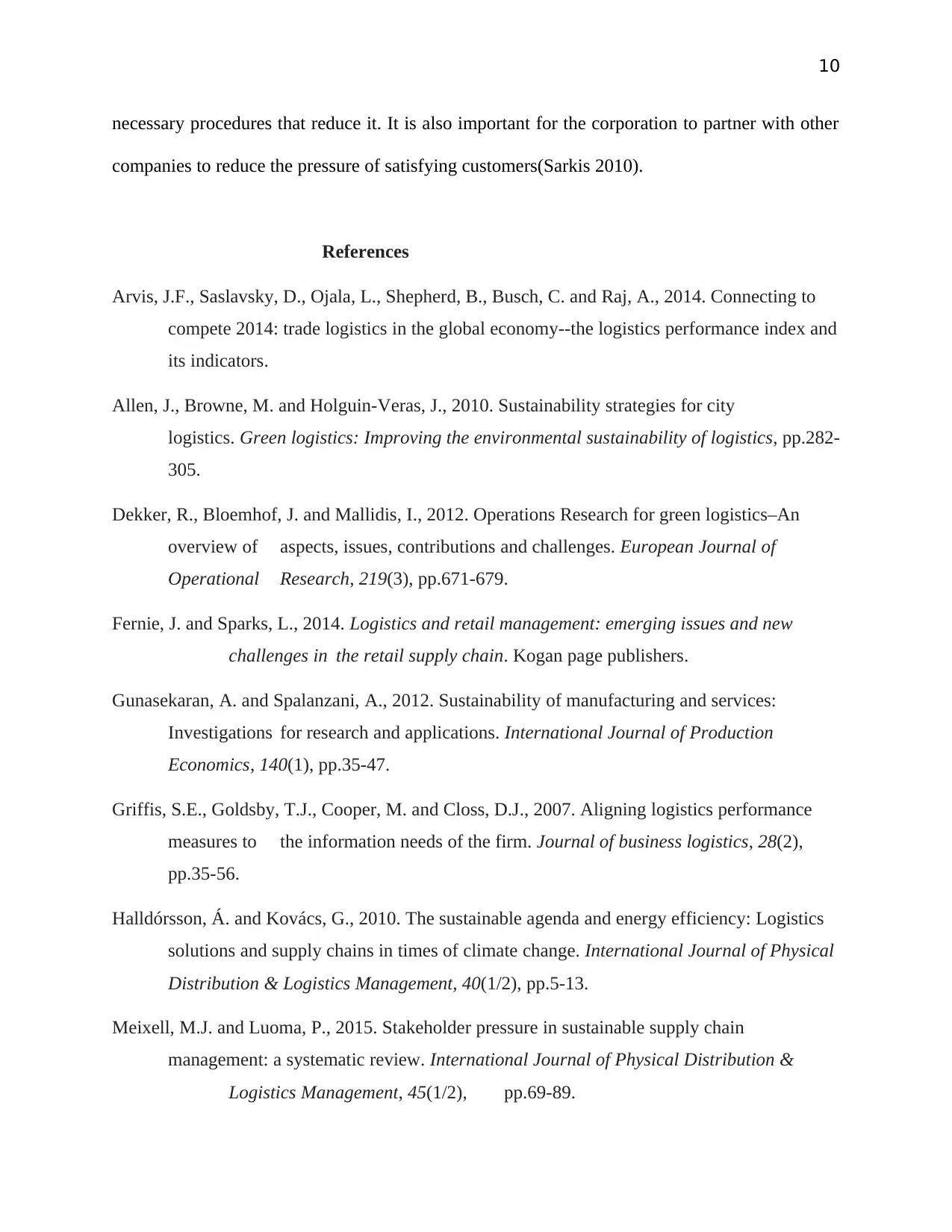
10
necessary procedures that reduce it. It is also important for the corporation to partner with other
companies to reduce the pressure of satisfying customers(Sarkis 2010).
References
Arvis, J.F., Saslavsky, D., Ojala, L., Shepherd, B., Busch, C. and Raj, A., 2014. Connecting to
compete 2014: trade logistics in the global economy--the logistics performance index and
its indicators.
Allen, J., Browne, M. and Holguin-Veras, J., 2010. Sustainability strategies for city
logistics. Green logistics: Improving the environmental sustainability of logistics, pp.282-
305.
Dekker, R., Bloemhof, J. and Mallidis, I., 2012. Operations Research for green logistics–An
overview of aspects, issues, contributions and challenges. European Journal of
Operational Research, 219(3), pp.671-679.
Fernie, J. and Sparks, L., 2014. Logistics and retail management: emerging issues and new
challenges in the retail supply chain. Kogan page publishers.
Gunasekaran, A. and Spalanzani, A., 2012. Sustainability of manufacturing and services:
Investigations for research and applications. International Journal of Production
Economics, 140(1), pp.35-47.
Griffis, S.E., Goldsby, T.J., Cooper, M. and Closs, D.J., 2007. Aligning logistics performance
measures to the information needs of the firm. Journal of business logistics, 28(2),
pp.35-56.
Halldórsson, Á. and Kovács, G., 2010. The sustainable agenda and energy efficiency: Logistics
solutions and supply chains in times of climate change. International Journal of Physical
Distribution & Logistics Management, 40(1/2), pp.5-13.
Meixell, M.J. and Luoma, P., 2015. Stakeholder pressure in sustainable supply chain
management: a systematic review. International Journal of Physical Distribution &
Logistics Management, 45(1/2), pp.69-89.
necessary procedures that reduce it. It is also important for the corporation to partner with other
companies to reduce the pressure of satisfying customers(Sarkis 2010).
References
Arvis, J.F., Saslavsky, D., Ojala, L., Shepherd, B., Busch, C. and Raj, A., 2014. Connecting to
compete 2014: trade logistics in the global economy--the logistics performance index and
its indicators.
Allen, J., Browne, M. and Holguin-Veras, J., 2010. Sustainability strategies for city
logistics. Green logistics: Improving the environmental sustainability of logistics, pp.282-
305.
Dekker, R., Bloemhof, J. and Mallidis, I., 2012. Operations Research for green logistics–An
overview of aspects, issues, contributions and challenges. European Journal of
Operational Research, 219(3), pp.671-679.
Fernie, J. and Sparks, L., 2014. Logistics and retail management: emerging issues and new
challenges in the retail supply chain. Kogan page publishers.
Gunasekaran, A. and Spalanzani, A., 2012. Sustainability of manufacturing and services:
Investigations for research and applications. International Journal of Production
Economics, 140(1), pp.35-47.
Griffis, S.E., Goldsby, T.J., Cooper, M. and Closs, D.J., 2007. Aligning logistics performance
measures to the information needs of the firm. Journal of business logistics, 28(2),
pp.35-56.
Halldórsson, Á. and Kovács, G., 2010. The sustainable agenda and energy efficiency: Logistics
solutions and supply chains in times of climate change. International Journal of Physical
Distribution & Logistics Management, 40(1/2), pp.5-13.
Meixell, M.J. and Luoma, P., 2015. Stakeholder pressure in sustainable supply chain
management: a systematic review. International Journal of Physical Distribution &
Logistics Management, 45(1/2), pp.69-89.
Paraphrase This Document
Need a fresh take? Get an instant paraphrase of this document with our AI Paraphraser
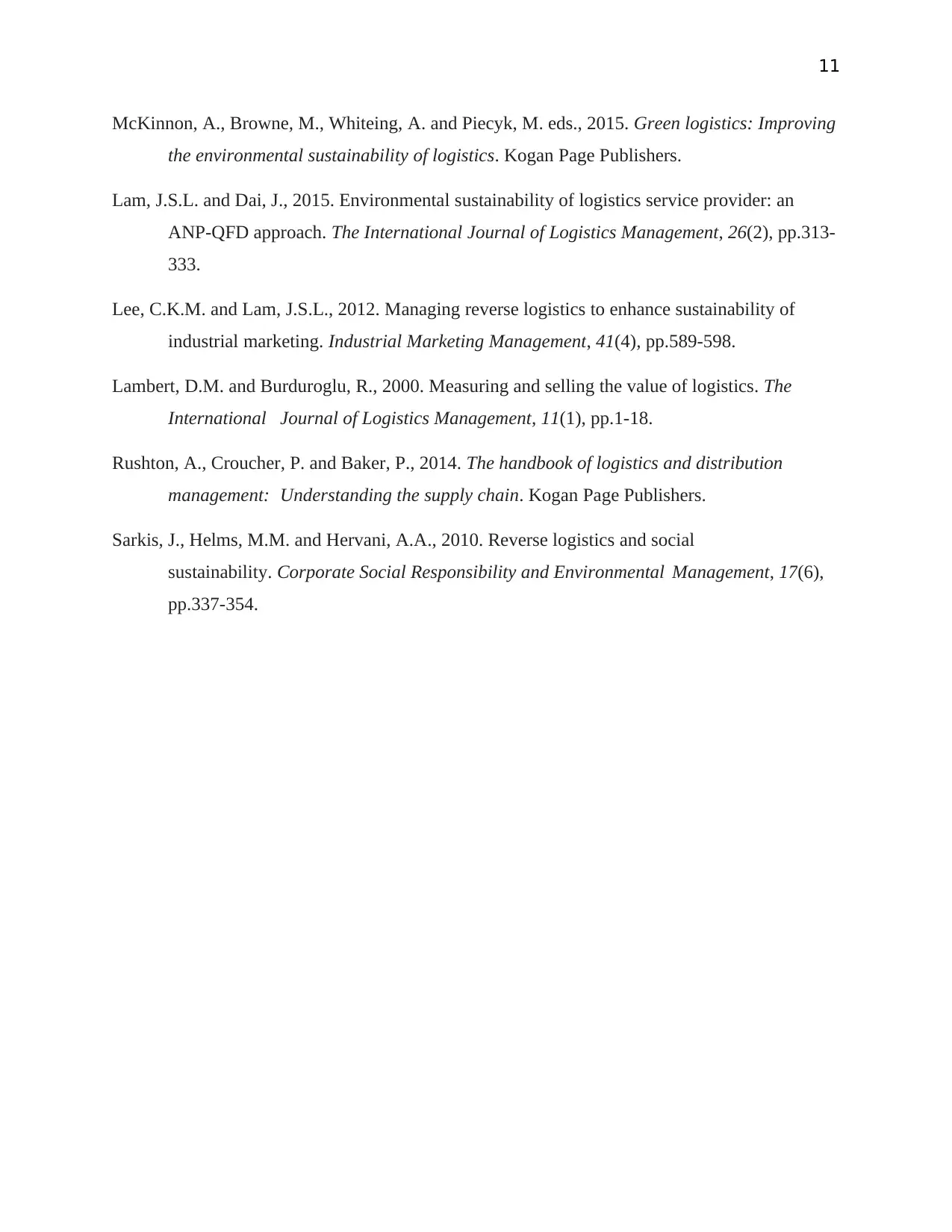
11
McKinnon, A., Browne, M., Whiteing, A. and Piecyk, M. eds., 2015. Green logistics: Improving
the environmental sustainability of logistics. Kogan Page Publishers.
Lam, J.S.L. and Dai, J., 2015. Environmental sustainability of logistics service provider: an
ANP-QFD approach. The International Journal of Logistics Management, 26(2), pp.313-
333.
Lee, C.K.M. and Lam, J.S.L., 2012. Managing reverse logistics to enhance sustainability of
industrial marketing. Industrial Marketing Management, 41(4), pp.589-598.
Lambert, D.M. and Burduroglu, R., 2000. Measuring and selling the value of logistics. The
International Journal of Logistics Management, 11(1), pp.1-18.
Rushton, A., Croucher, P. and Baker, P., 2014. The handbook of logistics and distribution
management: Understanding the supply chain. Kogan Page Publishers.
Sarkis, J., Helms, M.M. and Hervani, A.A., 2010. Reverse logistics and social
sustainability. Corporate Social Responsibility and Environmental Management, 17(6),
pp.337-354.
McKinnon, A., Browne, M., Whiteing, A. and Piecyk, M. eds., 2015. Green logistics: Improving
the environmental sustainability of logistics. Kogan Page Publishers.
Lam, J.S.L. and Dai, J., 2015. Environmental sustainability of logistics service provider: an
ANP-QFD approach. The International Journal of Logistics Management, 26(2), pp.313-
333.
Lee, C.K.M. and Lam, J.S.L., 2012. Managing reverse logistics to enhance sustainability of
industrial marketing. Industrial Marketing Management, 41(4), pp.589-598.
Lambert, D.M. and Burduroglu, R., 2000. Measuring and selling the value of logistics. The
International Journal of Logistics Management, 11(1), pp.1-18.
Rushton, A., Croucher, P. and Baker, P., 2014. The handbook of logistics and distribution
management: Understanding the supply chain. Kogan Page Publishers.
Sarkis, J., Helms, M.M. and Hervani, A.A., 2010. Reverse logistics and social
sustainability. Corporate Social Responsibility and Environmental Management, 17(6),
pp.337-354.
1 out of 11
Related Documents
Your All-in-One AI-Powered Toolkit for Academic Success.
+13062052269
info@desklib.com
Available 24*7 on WhatsApp / Email
![[object Object]](/_next/static/media/star-bottom.7253800d.svg)
Unlock your academic potential
Copyright © 2020–2025 A2Z Services. All Rights Reserved. Developed and managed by ZUCOL.





